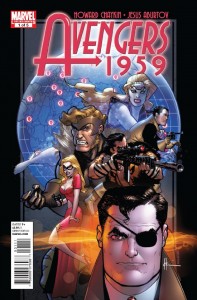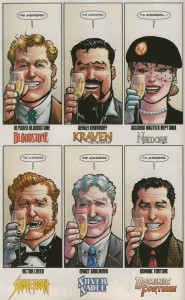 Since AMC’s show Mad Men became a hit by turning mid-20th century nostalgia into a bankable commodity and by casting Vincent Kartheiser in his second role where I want to stomp his balls off, it was only a matter of time before the copycats started showing up. Much like Raiders of the Lost Ark begat Tales of the Gold Monkey and Bring ‘Em Back Alive, this year Mad Men has given us the creatively leeched Pan Am and The Playboy Club… with pretty much the same predictable results.
Since AMC’s show Mad Men became a hit by turning mid-20th century nostalgia into a bankable commodity and by casting Vincent Kartheiser in his second role where I want to stomp his balls off, it was only a matter of time before the copycats started showing up. Much like Raiders of the Lost Ark begat Tales of the Gold Monkey and Bring ‘Em Back Alive, this year Mad Men has given us the creatively leeched Pan Am and The Playboy Club… with pretty much the same predictable results.
And so what with Marvel Comics hoping to bring in new readers and not being fools (Because Marvel doesn’t reboot! Marvel doesn’t NEED to reboot to keep their number one market sh… wait, what?), Marvel’s thrown their own hat in the Good-Old-Days ring with Avengers: 1959, apparently having missed the twin memos that the current trend is toward reliving the 1960’s, and that the last go-round with 1950’s nostalgia ended by jumping the shark. Literally.
Look: I’ve been around the block enough to know that the idea of a comics company sniffing for a bandwagon to jump on is hardly new. Let’s face reality: if Roy Thomas hadn’t snapped up Star Wars license, then Marvel would be the ones trying to pretend they hadn’t released Star Hunters – a comic so bad they pulled the “kill the hero and bring him back with a new costume to save the book” trick 120 days after the book started. Being a realist I know that if Mad Men was about Christopher Street in New York, Marvel would be releasing Avengers: What Price Glory Hole? right now. So I won’t try to hold the copycat feeling against this book.
Although keeping that feeling at bay is damn hard, because the first part of Avengers: 1959 all but screams “Look at our Mad Men-like setting!” When panel one shows Times Square in its whiskey and cigarette neon sign glory with dozens of period-specific cars, and the next five panels feature nattily-dressed bon vivants sipping champagne at The Stork Club, it’s hard not to get the message. And as to whether it’s a message that today’s comic geek wants to receive, well, I can only guess based on this year’s SDCC Doctor Who-to-Don Draper cosplay ratio. Or rather, I would be able to guess if it were possible to divide by zero.
But enough about the setting, let’s talk story. This is a continuation of the recent backup stories in New Avengers of Nick Fury’s first Avengers, a group of adventurers predating the rediscovery of Captain America, including Fury, Kraven the… ah, fuck it: these guys:
 In the backup, these Avengers fought the vestiges of the Nazis and the start of the Soviet Union. This book opens with them celebrating those victories and going their separate ways… only to fall under attack by several assassination attempts by an unknown foe rocking a skull icon embossed with the symbol for infinity. Huh; infinite head. What Price Glory Hole? But I digress.
In the backup, these Avengers fought the vestiges of the Nazis and the start of the Soviet Union. This book opens with them celebrating those victories and going their separate ways… only to fall under attack by several assassination attempts by an unknown foe rocking a skull icon embossed with the symbol for infinity. Huh; infinite head. What Price Glory Hole? But I digress.
From a storytelling standpoint, the split-up of the characters and their individual battles against assassins worked for me. It introduces the characters individually, which is a pretty standard storytelling device, but in a case where we have many who aren’t necessarily familiar, or with whom we are familiar but who are acting differently during the 50’s thanks to the lack of both available spandex costumes and laws against drunken driving, flying, or anything, it makes it simple to get to know them and decide whether or not we should give a damn about them beyond when they lived.
Turns out I do. The whole period thing might not turn me on, but I like knowing there’s a character who’ll push a skank out of an airplane with a wisecrack to save his own neck. Considering the worst Don Draper did was fake his name and lose chicks’ phone numbers, maybe I’ll like the 50’s better. But I digress again.
Look: at face value, the whole retro-50’s thing feels like a cheap cash-grab. I don’t really watch Mad Men, so the setting of this book on its own wouldn’t ever be enough to get me to pick it up. However, the story and art are by Howard Chaykin. And that makes the setting, cynical or not, a bonus. After all, this is the guy who did The Shadow, the criminally-underselling American Century, and the original Dominic Fortune book. He’d been writing and drawing stories set in the mid 20th century for at least fifteen years before Matthew Weiner was pitching thinly-veiled cock jokes for Party Girl. If Marvel is, in fact, looking for a big score on the back of period nostalgia, they picked the right man for the job.
With Chaykin penciling and inking his own stuff, it’s vintage… him. If you liked his art in American Flagg or Black Kiss or any other damn thing he’s ever done, you’ll like it here. The only nitpick, which I probably wouldn’t have even thought of if Amanda hadn’t pointed it out, is that every man Chaykin draws is a shave, haircut and color away from looking like Reuben Flagg. But then again, that’s the way it’s always been with Chaykin. If it’s never bothered you before, forget I said anything and and it won’t bother you now.
I still think the timing of this book stinks of bandwagon riding. But with that said, a period book by Howard Chaykin, with this much attention to character development and action along with getting the fender lines of a 56 Studebaker right, make this one I’m going to keep checking out.
Unless he brings in Vincent Kartheiser. But even if he does, this is Howard Chaykin we’re talking about, so he’d probably introduce him near a glory hole.
 Podcast RSS Feed
Podcast RSS Feed iTunes
iTunes Google Play
Google Play Stitcher
Stitcher TuneIn Radio
TuneIn Radio Android
Android Miro Media Player
Miro Media Player Comics Podcast Network
Comics Podcast Network